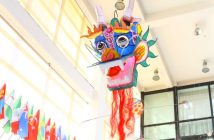
“The World is Thirsty,” reads the homepage of Beijing-based NGO Thirst. In just four words, Thirst manages to capture the heart of a global crisis that will impact everyone on the planet in the not too distant future; that is if it hasn’t already. The truth is that world is running out of drinkable water, a fact made starkly clear by the statistics on Thirst’s website. By 2025 two out of three people worldwide will lack access to clean, usable water and according to World Economic Forum, water scarcity is the number one global risk based on impact to society.
“In India, nearly three quarters of the population live in water-stressed regions yet demand for water continues to surge,” says Nathan Lawes, Thirst partnership and networks manager. “Earlier this year São Paulo, Brazil’s most populous city, ran out of water for four days and in the US, Californians have had to drastically change the way they use water.”
The facts about water scarcity don’t stack up much better in China, where according to Thirst’s data, 90 percent of the cities’ water is polluted. “We too must be quick to change our behavior if we are to tackle Beijing’s water crisis,” says Lawes.
Fortunately, all is not bleak. Lawes believes that it’s possible to stem this tide by changing the way we all use and consume water. Established by the World Economic Forum’s Young Global Leaders in 2012, Thirst tackles the monumental issue of world water scarcity and pollution crises through educating and engaging with the next generation of global consumers. In perhaps a sign of a growing awareness, Thirst was also recently featured as part of National Geographic Channel’s Earth Day series, aired across Asia, Africa, and the Middle East. We speak more to Lawes on the facts about water scarcity, Thirst’s education initiatives, and how to be part of the solution.
Where does Beijing stand in the water crisis relative to the rest of the world?
At the current rate of consumption, Beijing’s natural water reserves will be depleted by 2030 – that’s only 15 years away. 93 percent of China’s economy is dependent on water and almost half the world’s goods are made in the region. Beijing’s water is therefore not only of great importance to China, but the entire world. As a metropolis with more than 20 million inhabitants, but only one tenth the world’s average water resources, the city is not in the best position.
Is it possible to turn these numbers around?
Absolutely. The good news is that once we are aware of the magnitude of the global water crisis, all it takes is for each of us to consume water wisely and, more importantly, not to waste it in our everyday activities. There are many small actions we can take to that will make a big difference. For example, by taking part in Meat Free Monday your water footprint will be cut by 50 percent that day. That’s because livestock is one of the biggest consumers of water. Through modifying our everyday behavior, we can have a huge impact and turn this around together. (See sidebar for more tips from Thirst on how to conserve water)

What is Thirst’s main goal and what are the main challenges of achieving it?
Our goal is to create a water-wise world where families, schools, and companies are conscious of the water scarcity crisis and change their behavior accordingly. The main challenges to accomplishing these goals are two-fold. One facet is about understanding the concept of ‘virtual water’. The idea is that when you drink a 1-liter bottle of water, you are actually consuming three liters because water is used in making the plastic bottle. The idea of virtual water can sometimes be difficult to get your head around at first.
The second challenge is changing the thinking that water is plentiful. People need to understand the value of water and that some water is, contrary to common belief, finite and is consumed faster than it can be replenished. While both the planet and our bodies are two-thirds water, only 2.5 percent of the world’s water is usable and most of that is locked in the ice caps.
Tell us more about Thirst’s education initiatives.
We are currently rolling out a mass education program called the WE Water Experience. It’s in cooperation with the Foundation for UNESCO and Inditex, a Spanish fashion group. This is where we engage and educate the next generation to the world’s water crisis. We also leave Thirst Clubs in many of the schools we partner with, where kids actively participate in water-saving activities and water-related field trips. The majority of schools we go to are Chinese public schools, but we also visit international schools. This year, we’ve been to BISS, BIBS, Beijing City International School, Canadian International School, Harrow International School of Beijing, and Western Academy of Beijing. In this one program alone, we have educated over 30,000 students in hundreds of schools across China. A solid record, but we have more to do.
What impacts have you seen so far?
There is nothing more inspiring than seeing an entire school of students impassioned by water. Recently, we put on a ‘Water Hackathon’ at a Chinese public school in collaboration with American jeans company, Levi’s Strauss & Co. The students and Levi’s staff worked together to provide solutions to water scarcity issues and fiercely debated the merits of washing jeans with water. This is just one example of many where we have seen positive societal impacts in our three years as an organization, from the CEO of Levi’s Chip Bergh urging consumers not to use water to wash jeans to Chinese students in the tens of thousands turning the taps off when brushing their teeth and shortening their shower times.
How can people get involved in this issue?
You are already involved without knowing it. Every decision we make impacts the world’s water supply. We all need water to live. Remember that water not only powers economies, but is the reason for life itself. Whenever we explore a new planet, water is the first thing we look for. We owe it to ourselves to protect it: so start saving it, appreciating it, using it smartly, and most importantly, spread the word.
Thirst provides tips to conserve water at home
- Fix leaky taps. It saves water and money
- Cycle to work or school when the AQI is low. Bicycles don’t use gasoline, which relies on water to be pumped out of the ground
- When washing up or brushing your teeth, don’t leave the tap running
- Only use the dishwasher when the load is full
- Dispose of batteries at recycling points in your child’s school. One battery can contaminate an Olympic-sized swimming pool worth of water
- Drink tea instead of coffee. A cup of tea in place of coffee saves 105 liters of water – that’s enough for a 10-minute shower
- Eat less meat
Resources
For more information about Thirst or if you would like Thirst to visit your school, go to www.thirst4water.org or email them at info@thirst4water.org.
This article originally appeared on page 50-51 of the beijingkids July 2015 issue. Click here to read the issue for free on Issuu.com. To find out how you can get your own copy, email distribution@truerun.com.
Photo: courtesy of Thirst




1 Comment
Pingback: A Wave of Hope – NGO Thirst on what you need to know about water scarcity – Yvette Ferrari